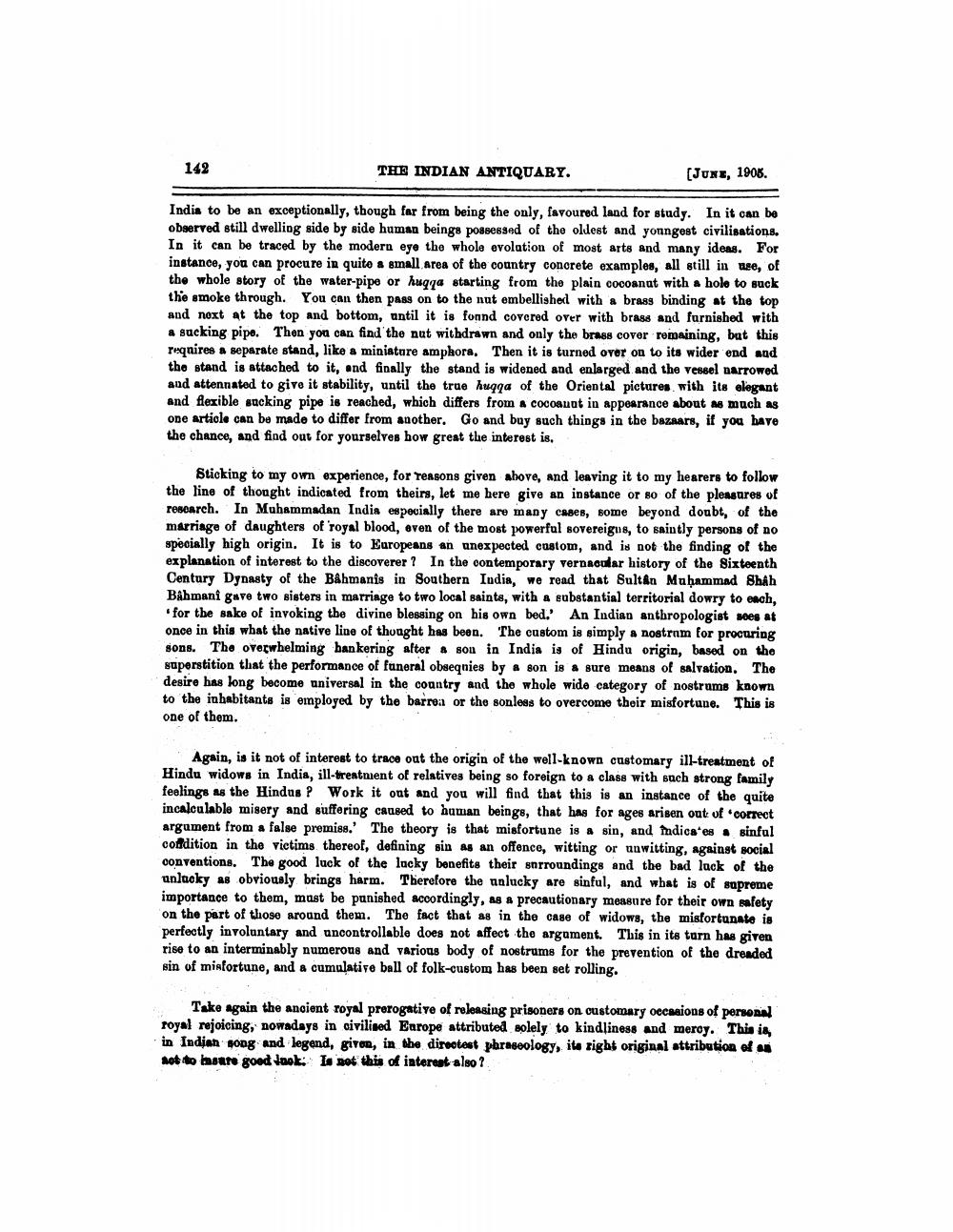________________
142
THE INDIAN ANTIQUARY.
[JUNE, 1905.
India to be an exceptionally, though far from being the only, favoured land for study. In it can be observed still dwelling side by side human beings possessed of the oldest and youngest civilisations. In it can be traced by the modern eye the whole evolution of most arts and many ideas. For instance, you can procure in quite a small area of the country concrete examples, all still in use, of the whole story of the water-pipe or huqqa starting from the plain cocoanut with a hole to suck the smoke through. You can then pass on to the nut embellished with a brass binding at the top and next at the top and bottom, until it is found covered over with brass and furnished with a sucking pipe. Then you can find the nut withdrawn and only the brass cover remaining, but this requires a separate stand, like a miniature amphora. Then it is turned over on to its wider end and the stand is attached to it, and finally the stand is widened and enlarged and the vessel narrowed and attenuated to give it stability, until the true huqqa of the Oriental pictures with its elegant and flexible sucking pipe is reached, which differs from a cocoaunt in appearance about as much as one article can be made to differ from another. Go and buy such things in the bazaars, if you have the chance, and find out for yourselves how great the interest is.
Sticking to my own experience, for reasons given above, and leaving it to my hearers to follow the line of thought indicated from theirs, let me here give an instance or so of the pleasures of research. In Muhammadan India especially there are many cases, some beyond doubt, of the marriage of daughters of royal blood, even of the most powerful sovereigns, to saintly persons of no specially high origin. It is to Europeans an unexpected custom, and is not the finding of the explanation of interest to the discoverer? In the contemporary vernacular history of the Sixteenth Century Dynasty of the Bâhmanis in Southern India, we read that Sultan Muhammad Shah Bahmani gave two sisters in marriage to two local saints, with a substantial territorial dowry to each, 'for the sake of invoking the divine blessing on his own bed.' An Indian anthropologist sees at once in this what the native line of thought has been. The custom is simply a nostram for procuring sons. The overwhelming hankering after a son in India is of Hindu origin, based on the superstition that the performance of funeral obseqnies by a son is a sure means of salvation. The desire has long become universal in the country and the whole wide category of nostrums known to the inhabitants is employed by the barrea or the sonless to overcome their misfortune. This is one of them.
Again, is it not of interest to trace out the origin of the well-known customary ill-treatment of Hindu widows in India, ill-treatment of relatives being so foreign to a class with such strong family feelings as the Hindus? Work it out and you will find that this is an instance of the quite incalculable misery and suffering caused to human beings, that has for ages arisen out of 'correct argument from a false premiss.' The theory is that misfortune is a sin, and indicates a sinful condition in the victims thereof, defining sin as an offence, witting or unwitting, against social conventions. The good luck of the lucky benefits their surroundings and the bad luck of the unlucky as obviously brings harm. Therefore the unlucky are sinful, and what is of supreme importance to them, must be punished accordingly, as a precautionary measure for their own safety on the part of those around them. The fact that as in the case of widows, the misfortunate is perfectly involuntary and uncontrollable does not affect the argument. This in its turn has given rise to an interminably numerous and various body of nostrums for the prevention of the dreaded sin of misfortune, and a cumulative ball of folk-custom has been set rolling.
Take again the ancient royal prerogative of releasing prisoners on customary occasions of personal royal rejoicing, nowadays in civilised Europe attributed solely to kindliness and mercy. This is, in Indian song and legend, given, in the directest phraseology, its right original attribution of an act to insure good look: Is not this of interest also?




